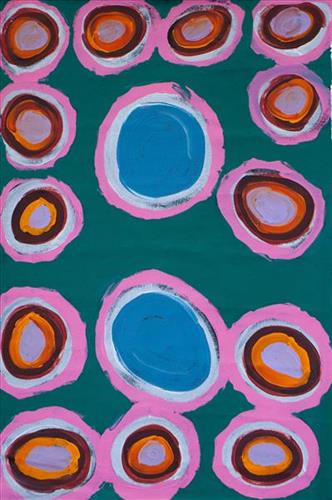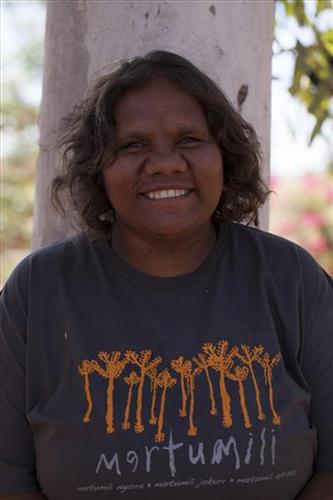111581938145
Pinpi (Durba Springs) – Judith Anya Samson
This painting is part of the Nyina-ya ngurrangka ngampurrpa (stay in your home safely) collection – a body of works by Martu artists in lockdown. From Monday 16th March Martumili Artists closed on-site art-production and retail, as a protective measure in the face of the COVID-19 pandemic. The remote Martu communities of Parnngurr, Punmu, Kunawarritji, Warralong and Jigalong went into lockdown, with access to visitors strictly prohibited to protect community members, and in particular the important elders that call Martu Country home. Martu Artists who found themselves on Country during lockdown had the opportunity for reconnection with their daily art practice, undisturbed by busy contemporary life as Australia, and indeed the world, slowed down in the face of the global pandemic.
This collection of artworks showcases the unstoppable determination of Martu Artists in their work, and demonstrates a deep and enduring commitment to art-making as an act of cultural preservation and social connection. Martu elders use paintings as a means to pass on stories of Country, jukurrpa (dreaming), family histories and traditional environmental knowledge to younger family members. To Martu Artists, painting is connection. And in times of isolation and lockdown, they have remained connected to eachother, and to their Country.
“It’s nice at Pinpi (Durba Springs). There’s lots of kapi (water). We go swimming there. My nanna [Dadda Samson] and me drank that water when I was a little girl with my nanna and pop. We dug up the sandhills with shovels to drink the kapi, cold kapi. We got lots of that kapi.”
– Judith Anya Samson
Pinpi is a spring and adjacent cave located just south east of Jilukurru (Killagurra Spring, Canning Stock Route Well 17). This site forms part of Anya’s ngurra (home Country, camp) through her grandmother, Dadda Samson.
Pinpi is an important site in the Wati Kujarra (Two Goanna Men) Jukurrpa (Dreaming) narrative, and the red rock walls surrounding the spring feature many paintings referencing this story. The Wati Kujarra existed as half men, half goanna. They were responsible for the creation of many land features in Martu Country and beyond as they travelled, hunted and burned Country together. Wati Kujarra is a ngurlu (sacred, taboo) men’s story, and for this reason much of the content is only shared with initiated men.




